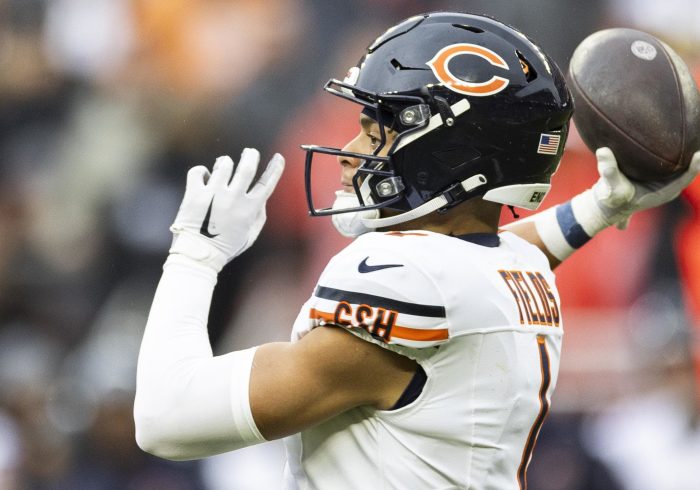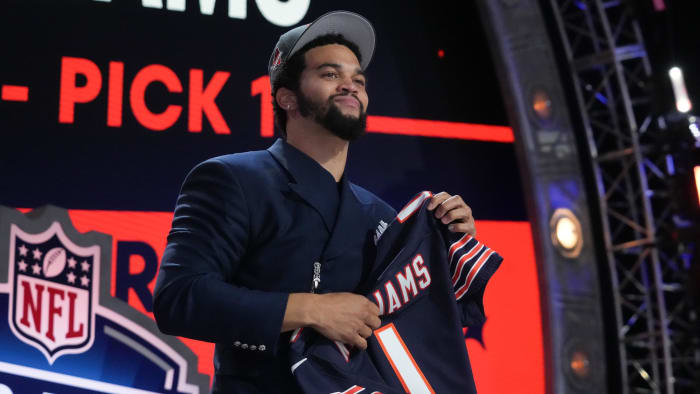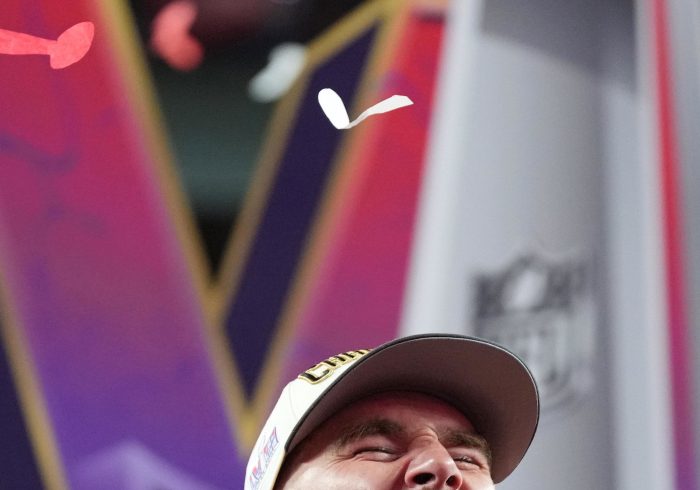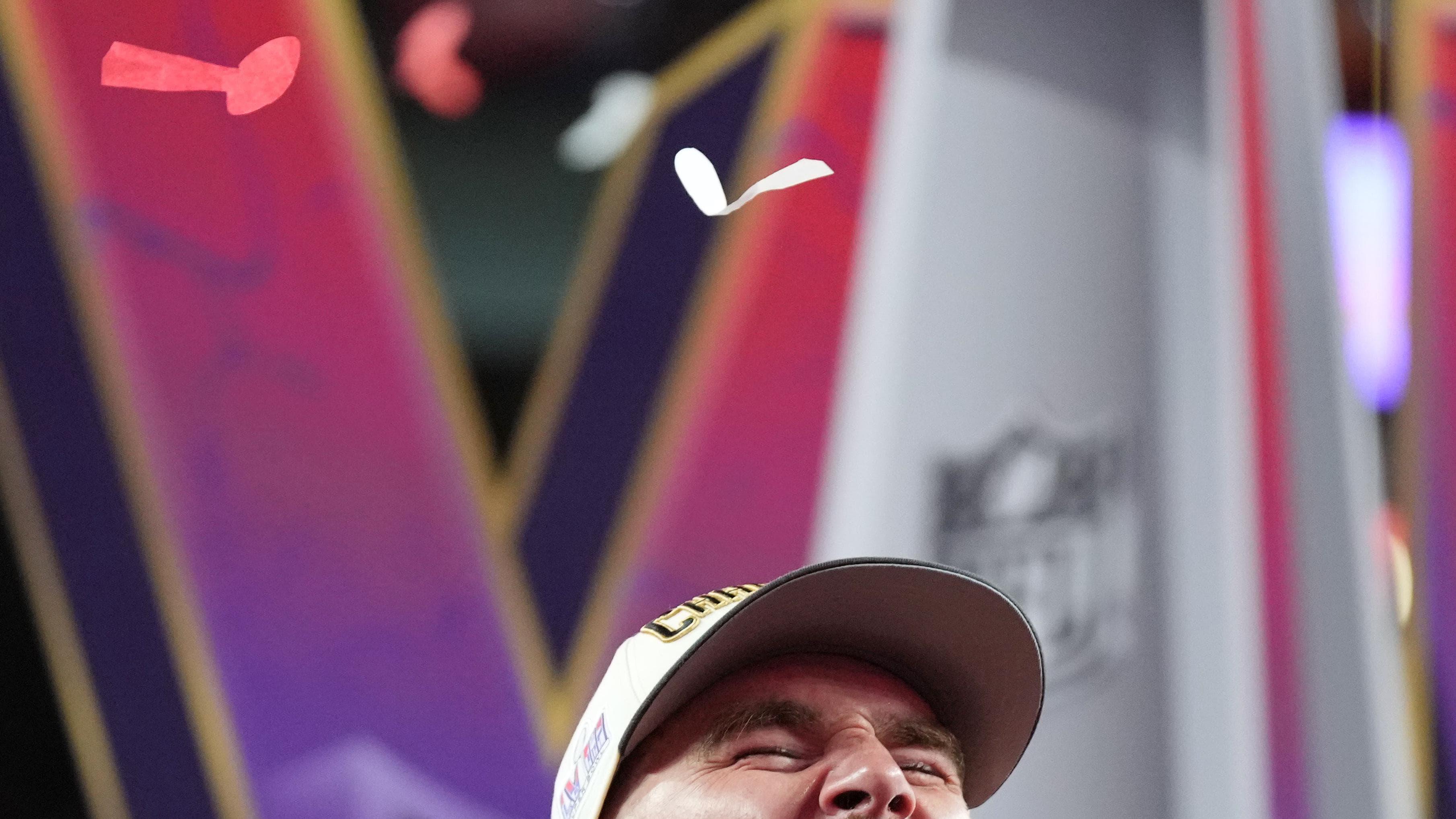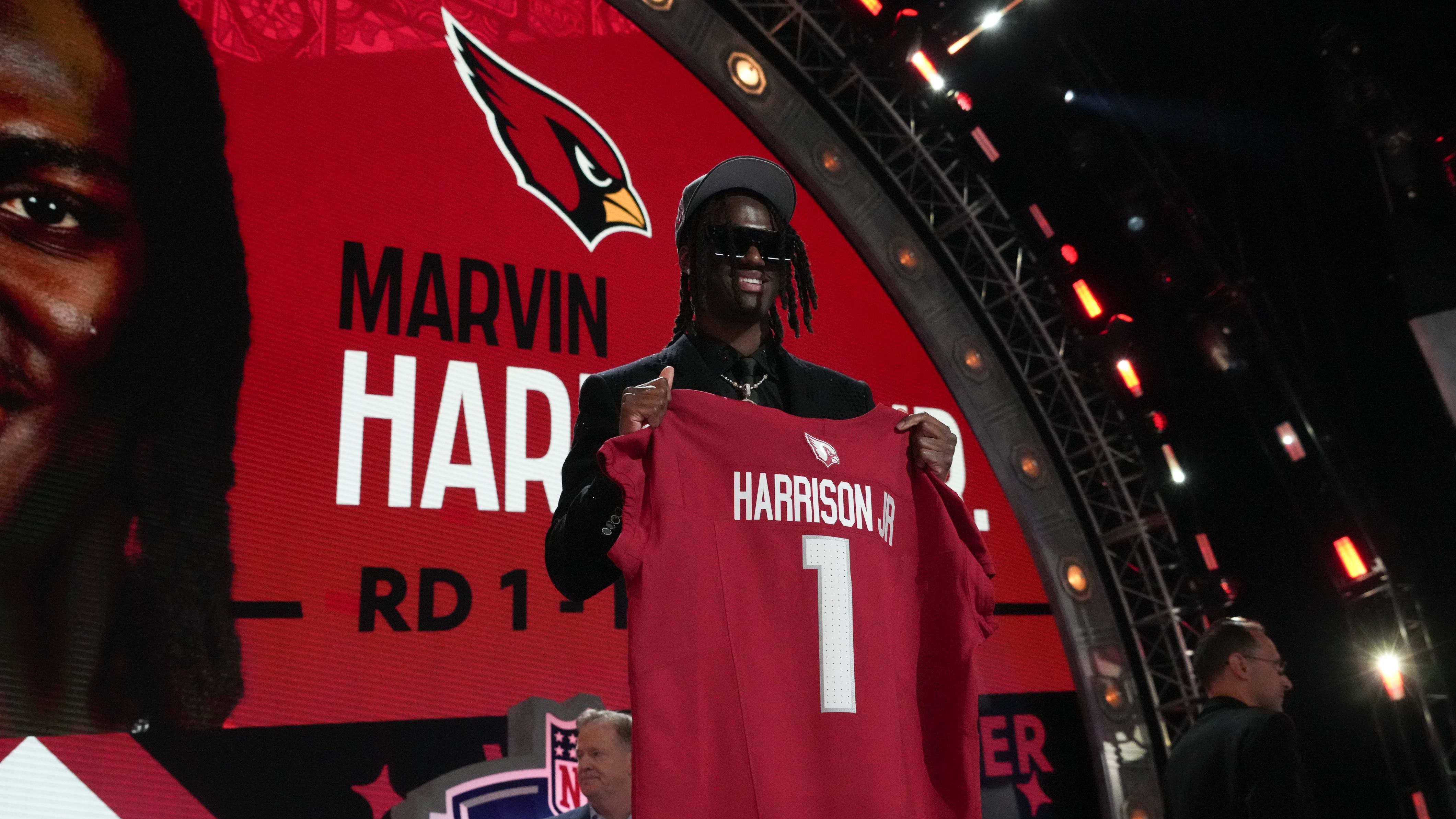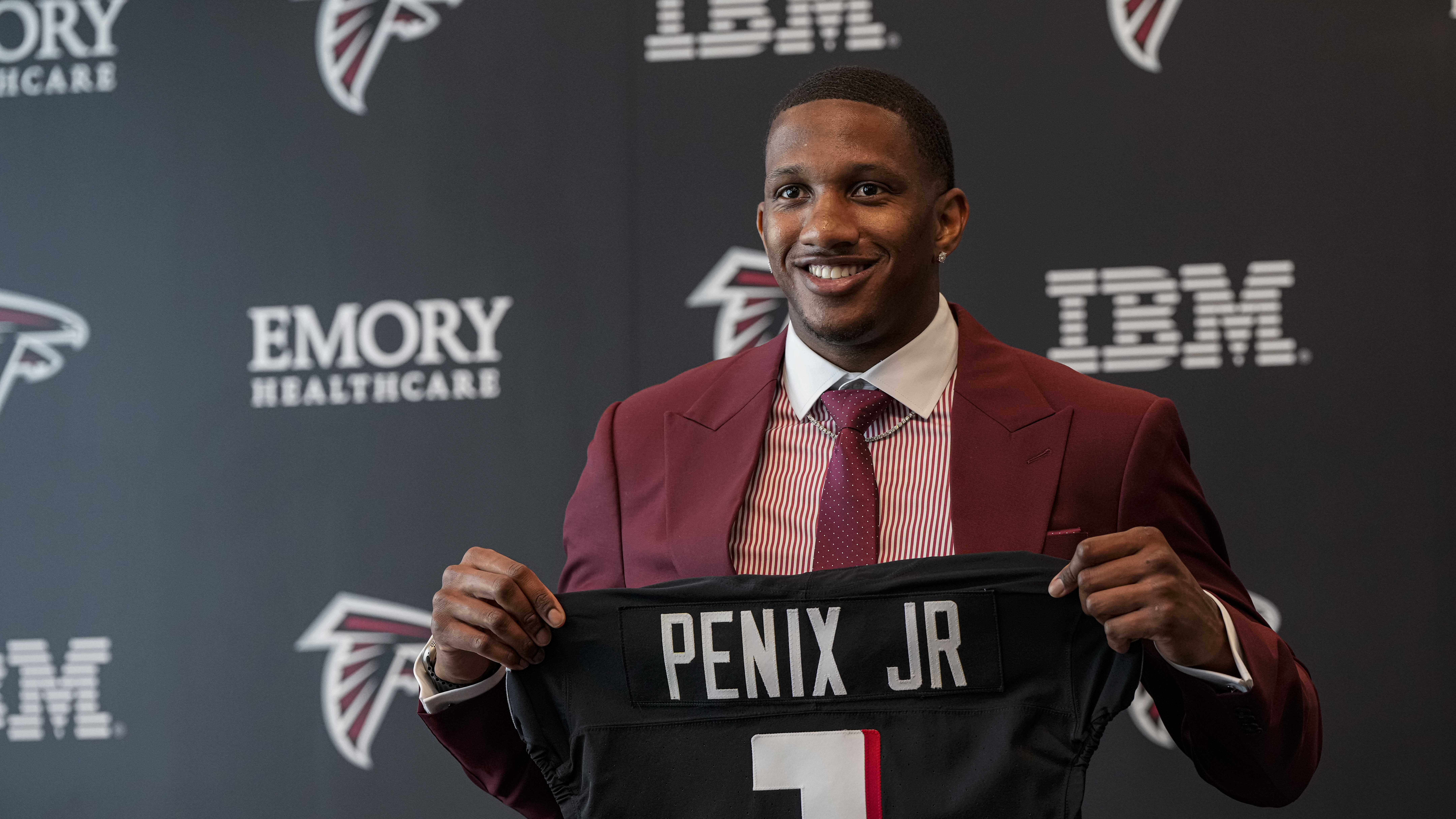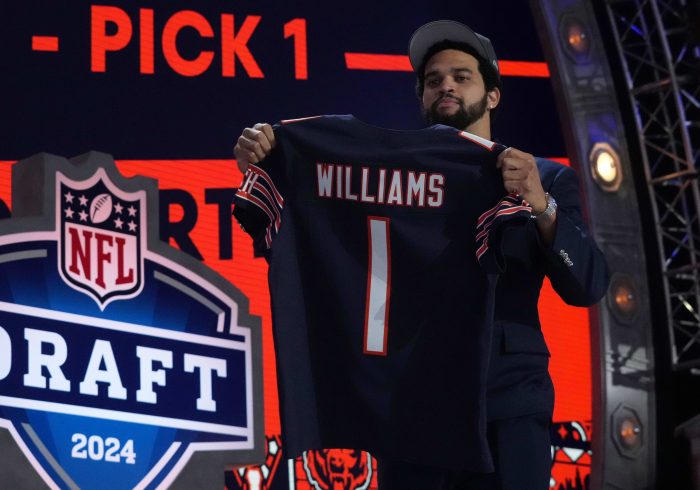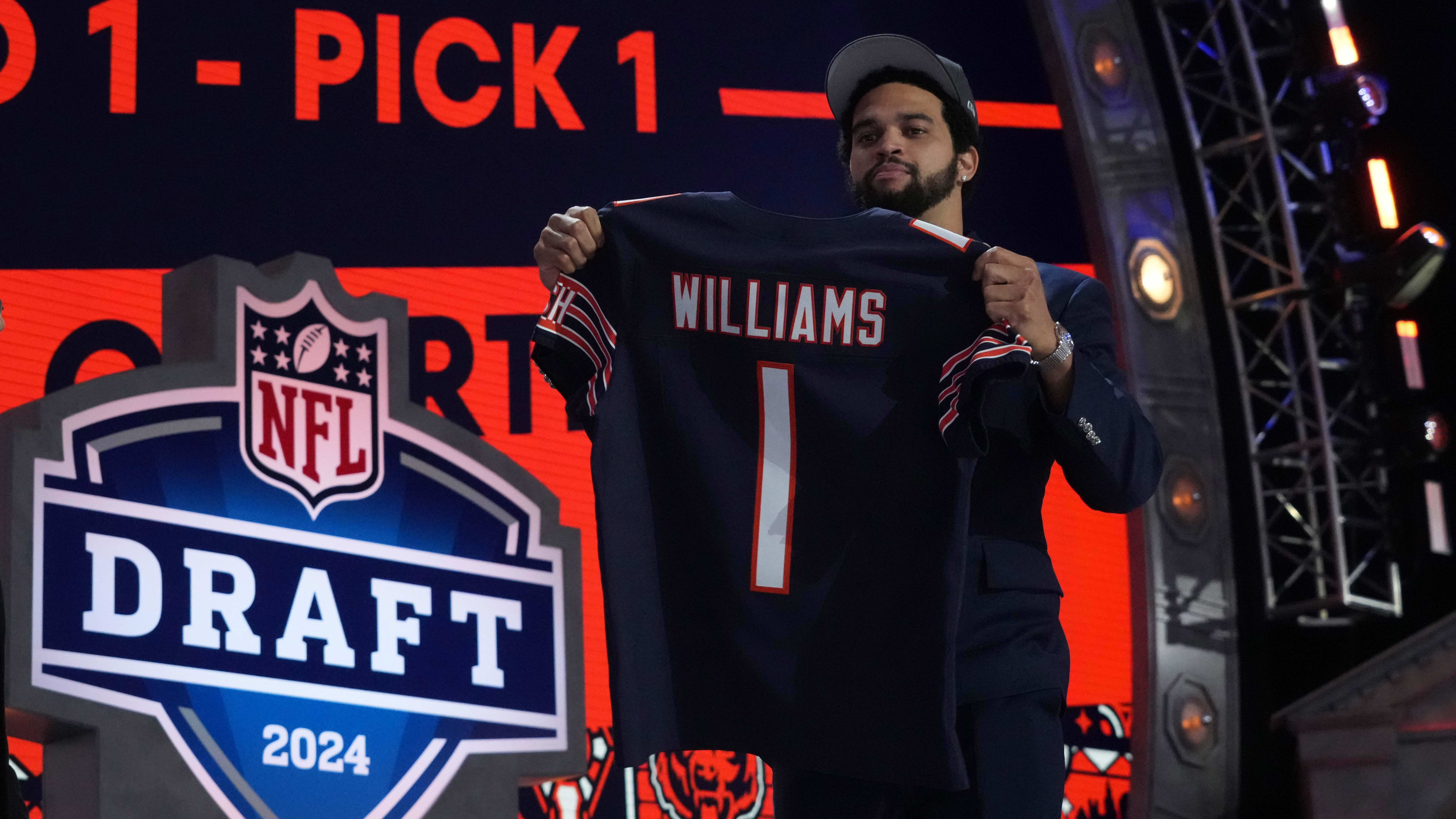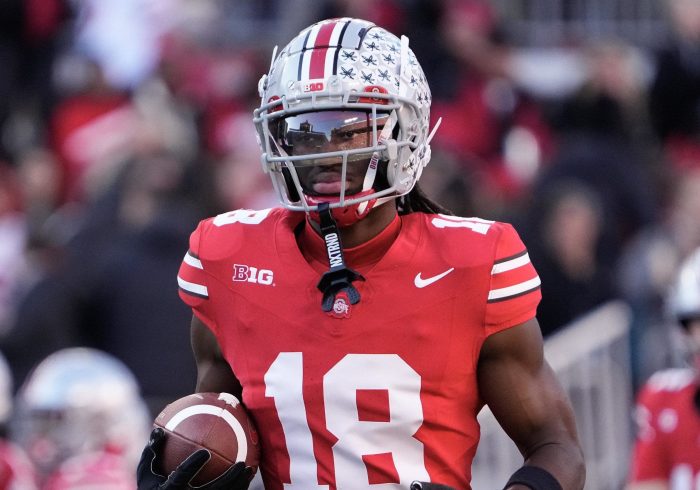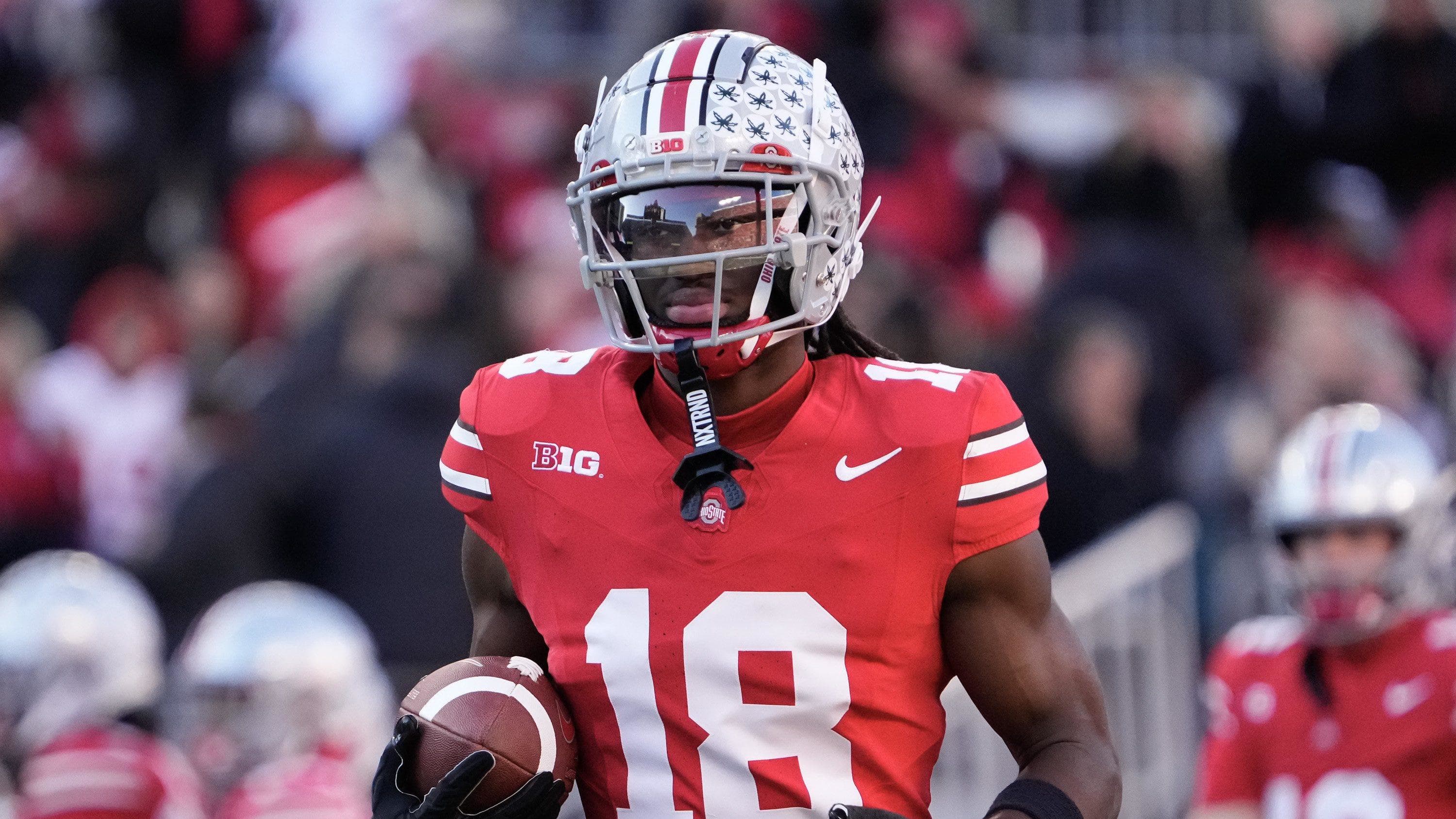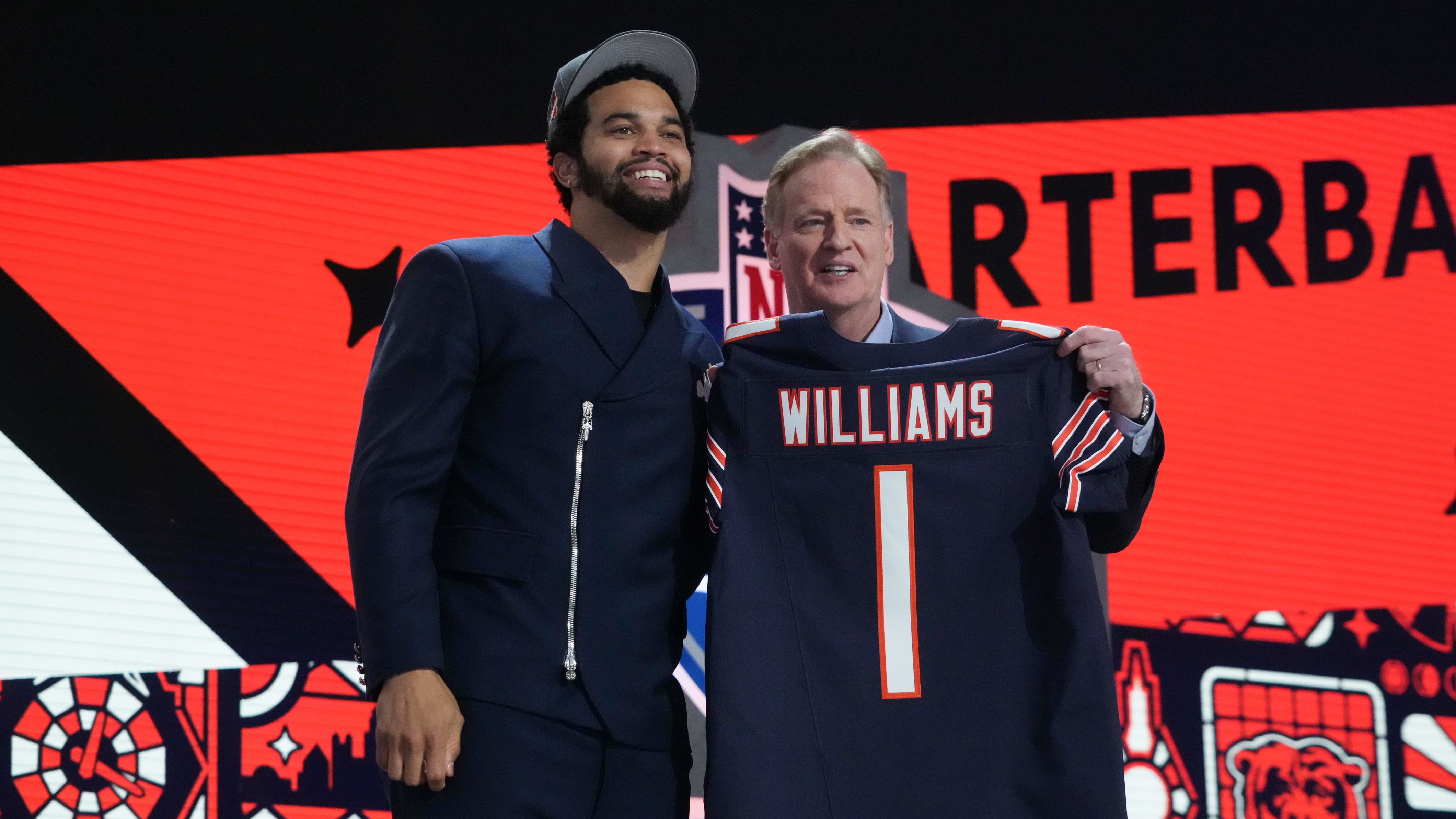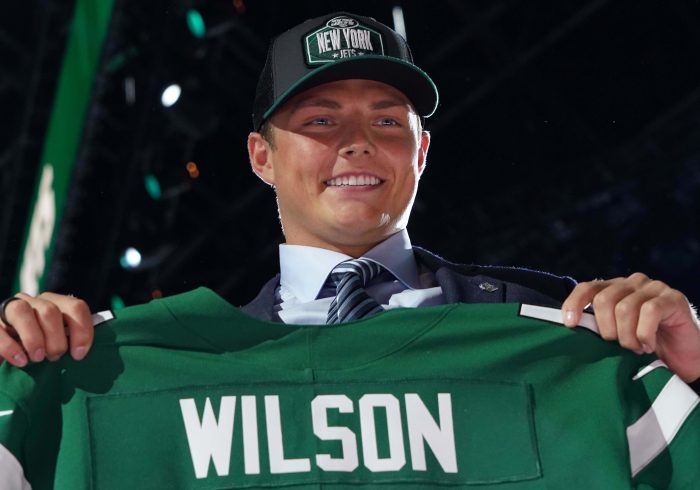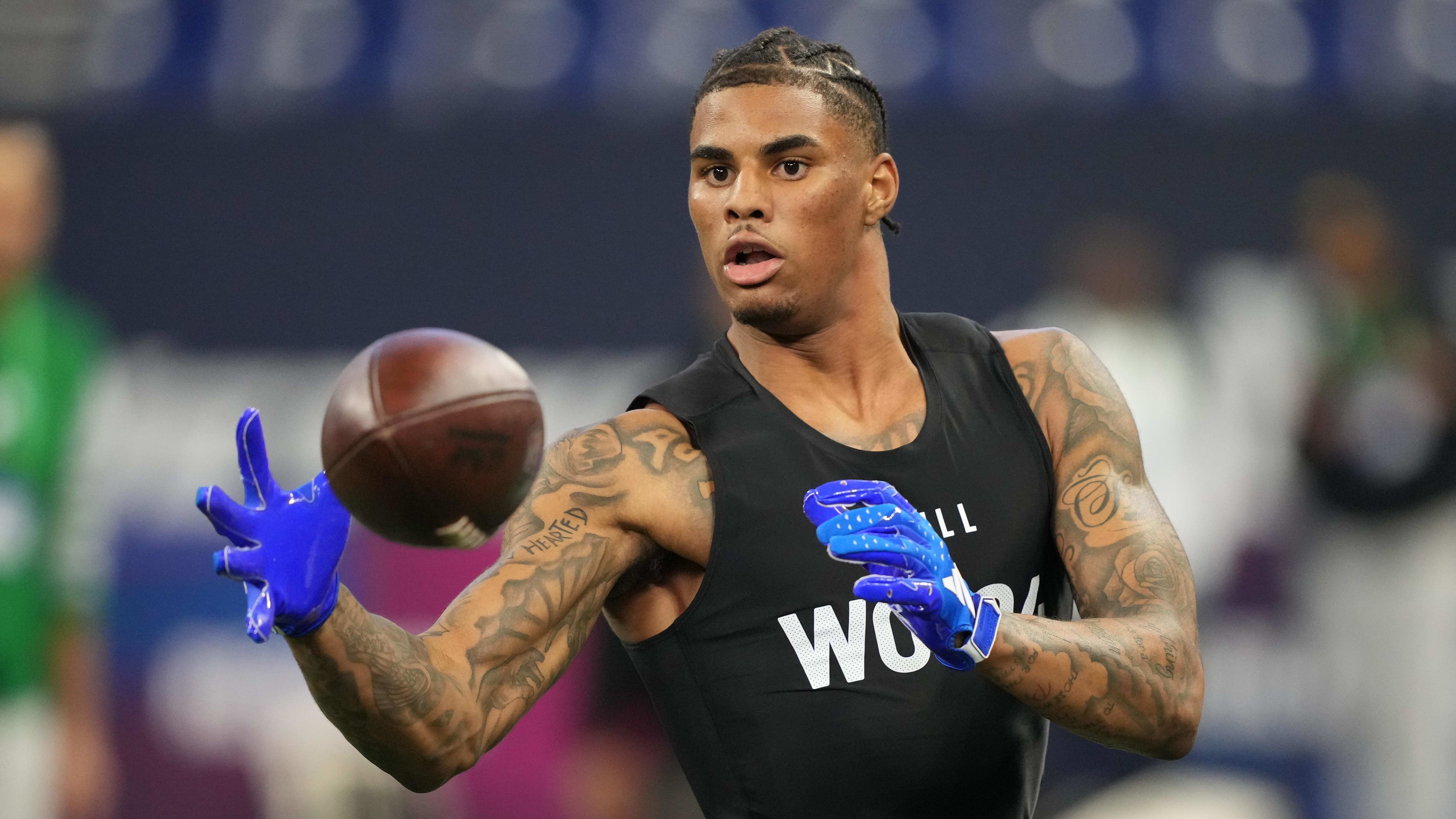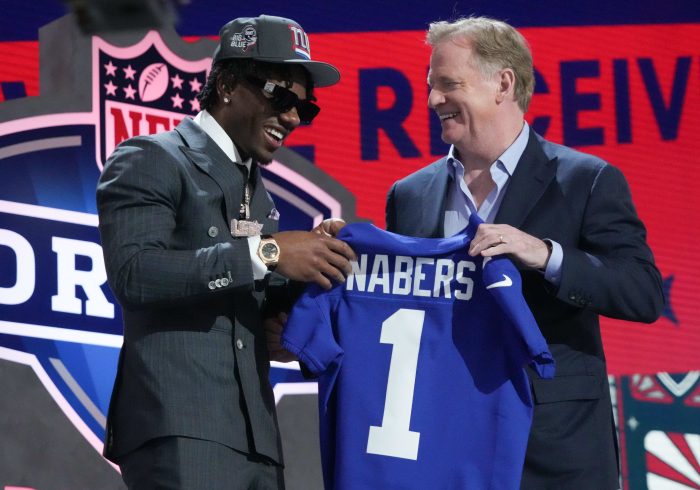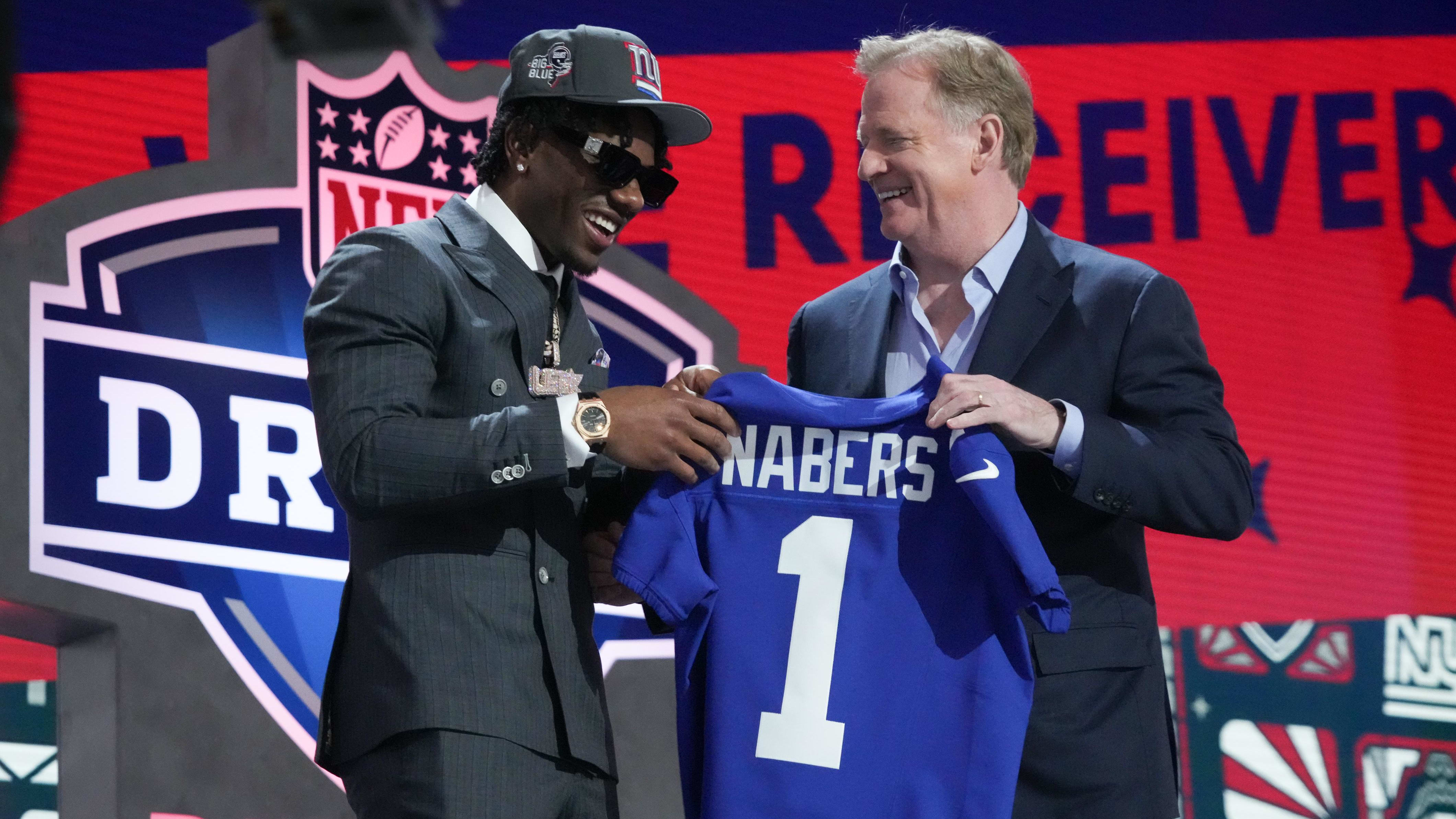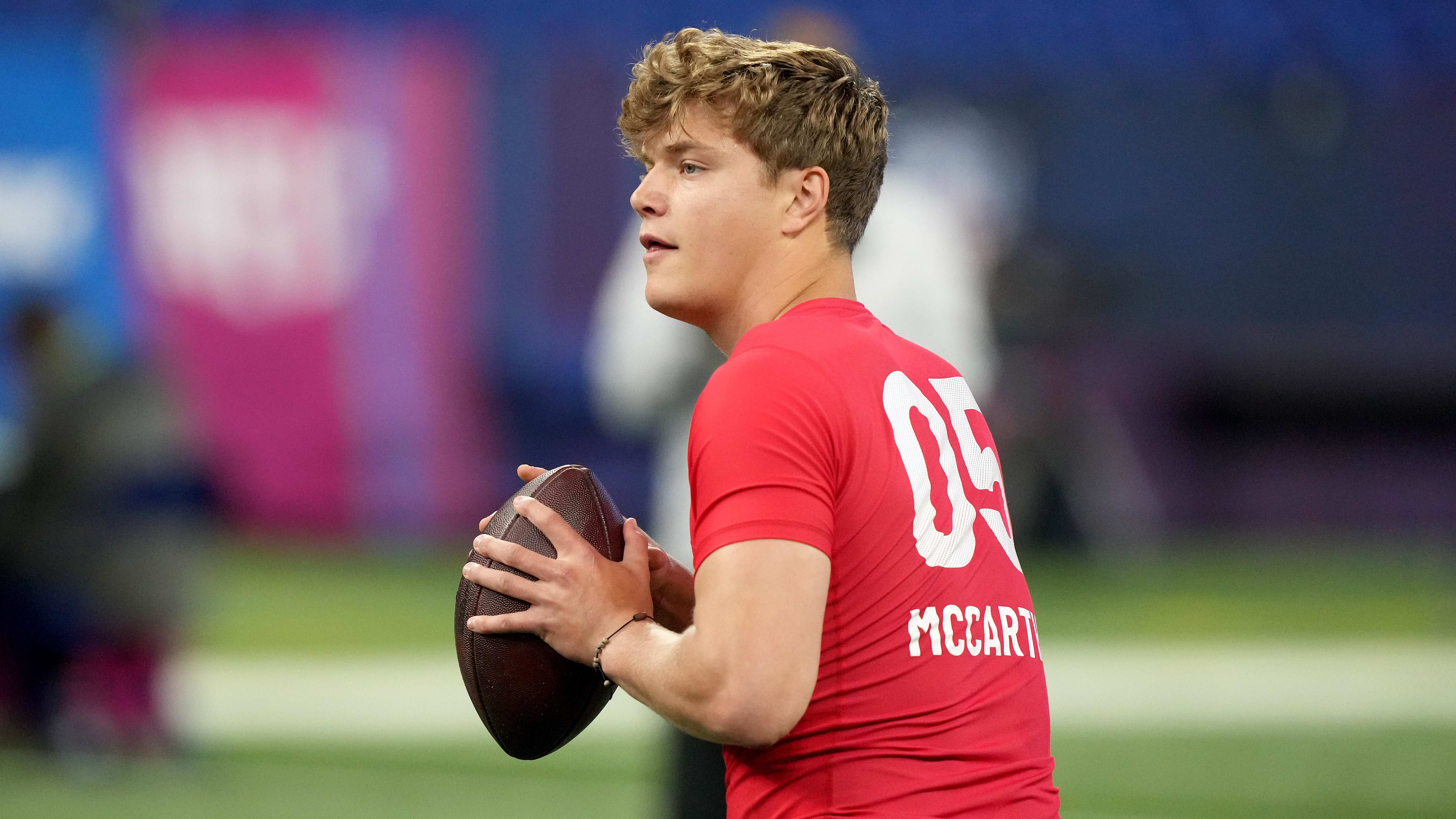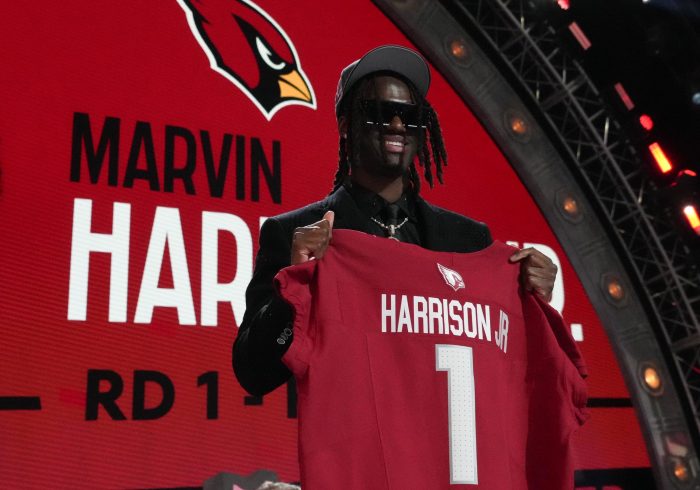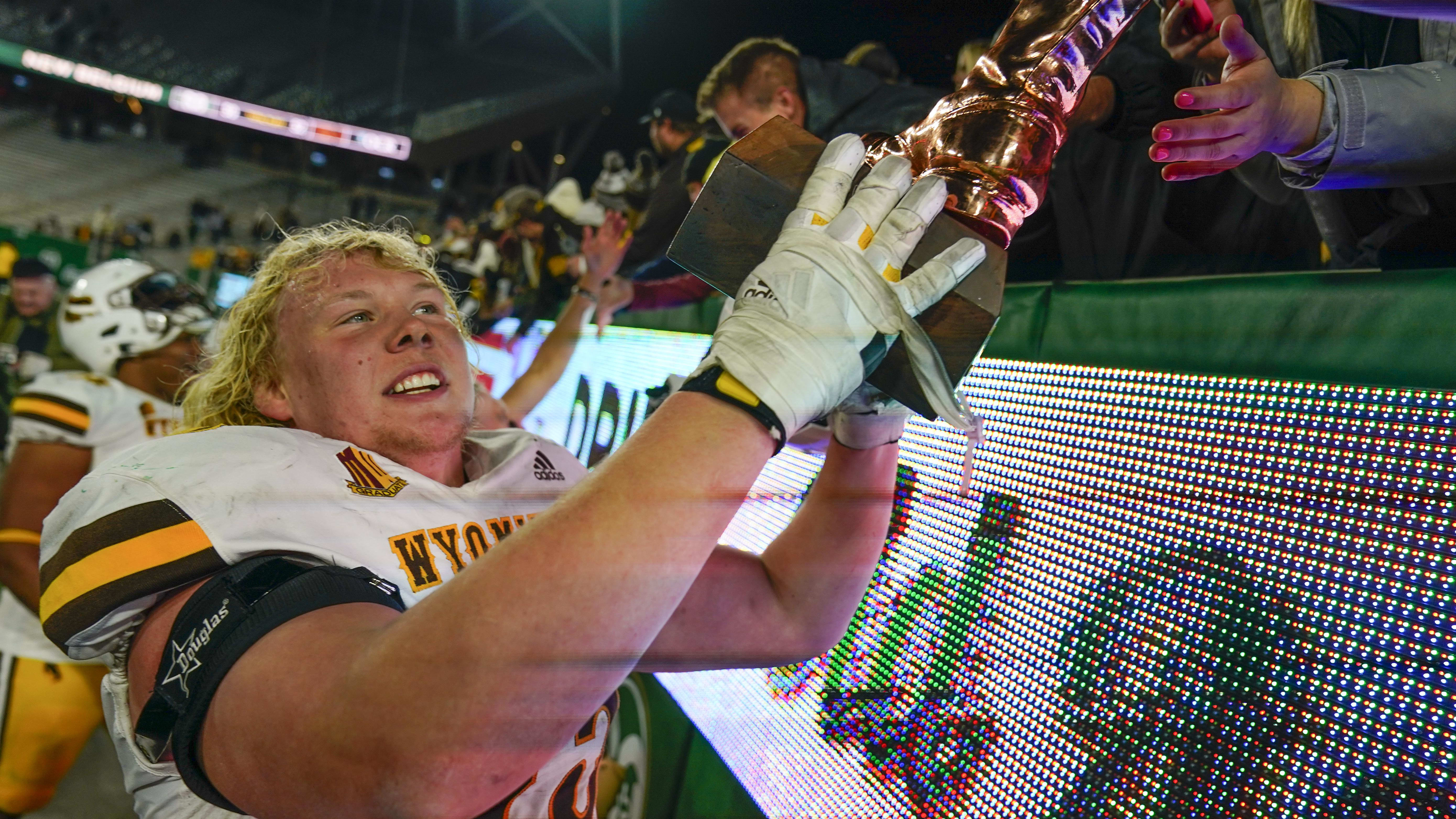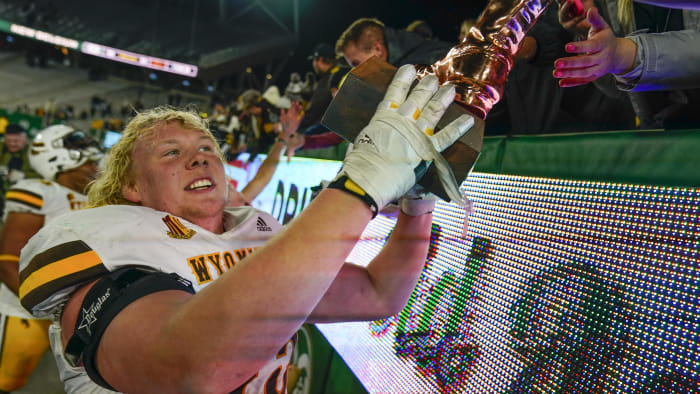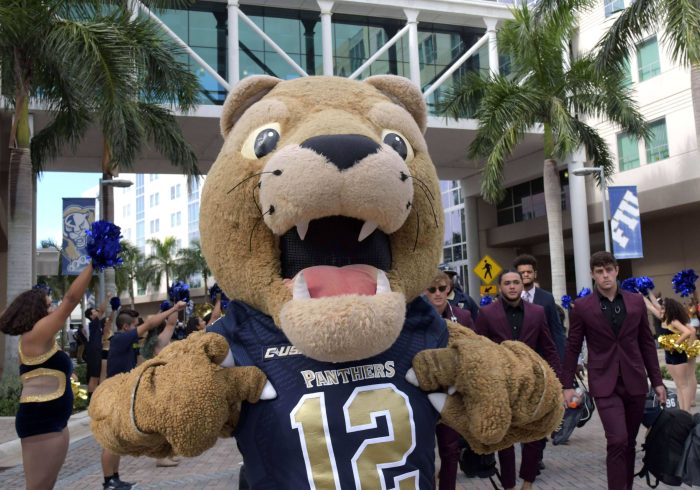Inside the Bears’ Process of Scouting Caleb Williams Before Drafting Him No. 1
It was Oct. 14 in South Bend, Ind., and Chicago Bears GM Ryan Poles was working the sideline as he normally would at a college game in the fall—looking, with a scout’s eye, for any little window he could find into the prospects he’d be evaluating in the winter and spring.
The USC offense was wrapping up warmups. The punt team was coming on. The Trojans’ reigning Heisman-winning quarterback, Caleb Williams, had looked over to the Irish sideline earlier, and spotted Notre Dame icon, and NFL legend, Joe Montana. Sensing the timing was right, he put his head down and went.
Poles watched intently.
Williams was born in November 2001, nearly seven years after Montana played his last game. Some of his contemporaries wouldn’t even know who Montana was, let alone recognize him in street clothes. But here was Williams, preparing for his final shot at Notre Dame as USC quarterback, compelled to pay homage to one of the game’s greats.
“They went to do some special teams things, he took his helmet off, ran over and shook his hand,” Poles said Thursday. “For a young kid to go up to a quarterback like that, Hall of Famer, and not as an, I’m in the same circle as you, but I look up to you, and, yet, there wasn’t this college fear of talking to an adult. He did it with confidence and swagger, but a ton of respect and humility at the same time—I couldn’t get that out of my mind.”
At the time, there was no way for Poles to know he’d have a prayer of landing Williams in the draft.
Sure, he had two first-round picks, and with the Bears’ record at 1–4 and the Carolina Panthers’ 0–5, there was a good chance both would be in the top 10. Still, he and his coach, Matt Eberflus, were headlong in the process of evaluating Justin Fields, coming off one of his best games as a pro, a four-touchdown effort in a Thursday Night Football win over the Washington Commanders, and it was pretty well-established by then that only one NFL team would have a shot at USC’s quarterback. There was also a lot of season left to be played.
So Poles filed the memory away, an early step he’d take in executing the Bears’ aggressive, forward-thinking plan to both give Fields a shot and be prepared for whatever opportunity Chicago’s draft position afforded him at the position.
This week, we’re going to take you, soup to nuts, through that plan, and how it got Poles and Eberflus to the point where they were ready to trade Fields and tie their job security to a guy who’s been tagged a generational talent at the position since he was a teenager. And what you’ll see is that just as that sort of big-picture view of the quarterback was important, so too were all the little details along the way.
Even if it was just that short interaction before the worst game of Williams’s college career.
We’re into a lull in the NFL offseason, with OTAs still a couple of weeks away, and the draft in the rearview mirror. But the league doesn’t really ever sleep, so we’ve got plenty to cover, and in this week’s Takeaways, that’ll bring you …
• A look at the Miami Dolphins’ marriage with Odell Beckham Jr., and why Beckham came so cheap.
• Why Olu Fashanu was the play for the New York Jets, and which skill-position player they saw on his level.
• The Buffalo Bills’ strategy in moving around before landing Keon Coleman.
… And a whole lot more.
But we’re starting this week with a look back at the top of the draft, and how the Bears got comfortable with the guy we’ve all assumed for a year now would go with the first pick.
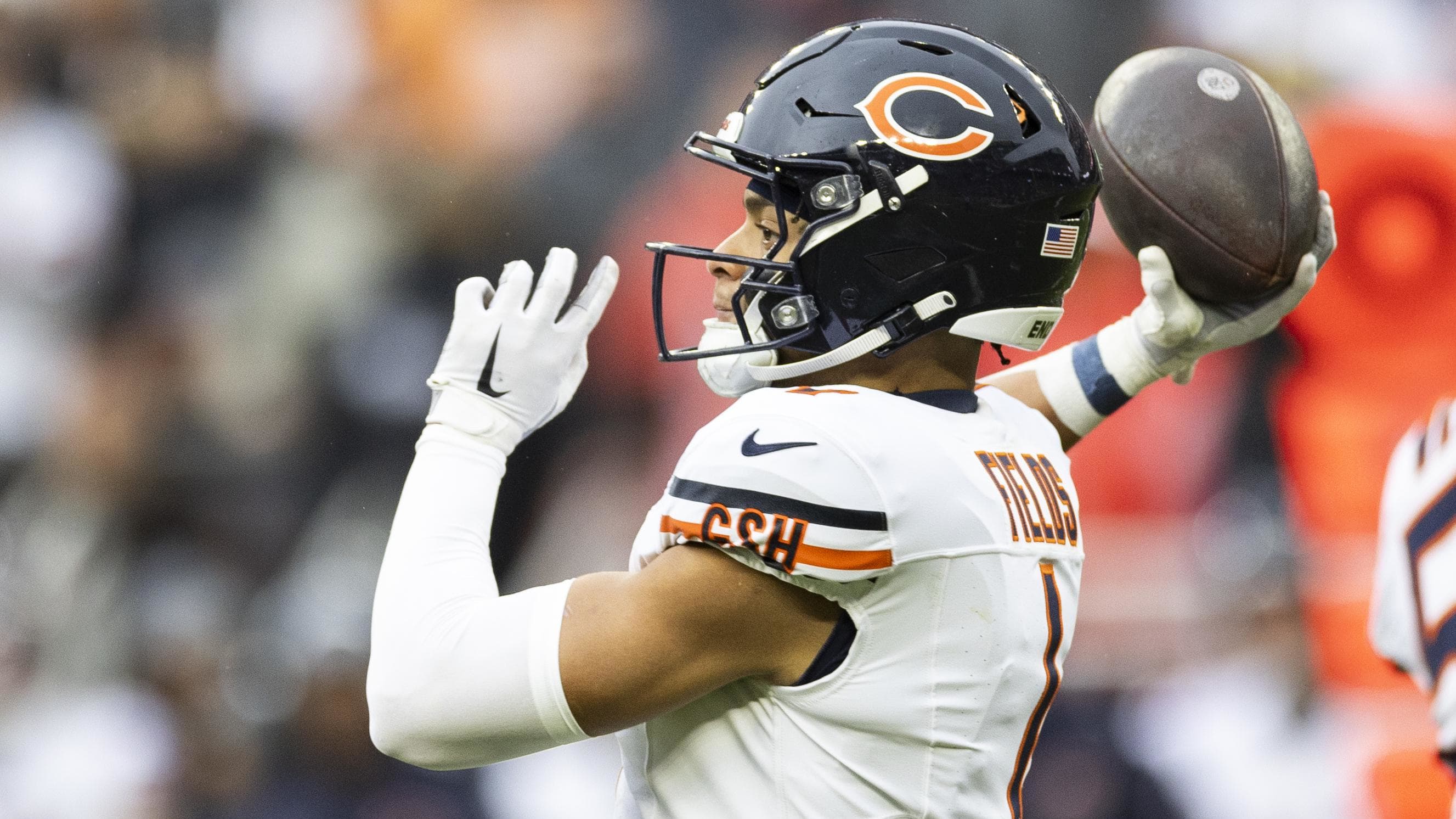
Because of a trade with the Panthers the previous year, the Bears didn't have to finish the 2023 season at the bottom of the league in order to get the top pick, which put Fields's future in Chicago in doubt.
Scott Galvin-USA TODAY Sports
The search for the next quarterback in Chicago had a soft opening, because the Bears’ situation going into the 2023 season demanded that.
Fields was going into his third year, after which the Bears would have to make a decision on his fifth-year option, priced out, fully guaranteed, at more than $20 million for 2025. Meanwhile, because of the trade with Carolina last year, Chicago didn’t have to be at the bottom of the league to get the top pick—meaning that Fields could play reasonably well and still face the reality that the Bears had a better option out there than just paying him.
So the team was judicious in kicking the process off. Step one was Poles mapping out an itinerary that would allow for him to see each of the top quarterbacks live in the fall.
With the benefit of a private jet, he went to Ann Arbor to see Michigan’s J.J. McCarthy against ECU, and Charlotte to see North Carolina’s Drake Maye against South Carolina on the Saturday of Labor Day weekend, then LSU’s Jayden Daniels against Florida State the next day in Orlando. He pulled a similar double over Thanksgiving weekend, with Oregon’s Bo Nix and Washington’s Michael Penix Jr. on back-to-back days in Eugene and Seattle, against their respective rivals, Oregon State and Washington State. Plus there was USC at Notre Dame.
In each case, Poles had the benefit of seeing the guys throw the ball live. But, as the Montana anecdote illuminates, there was a lot more he was looking to come home with than what people could see with their cable subscriptions on those weekends.
“When you watch quarterbacks, you’re looking at body language more than even the game,” Poles says. “You can get the game by watching the tape. It’s really pregame, how they carry themselves. During the game, if something good happens, how do they react? If it was a bad play, an interception, what does it look like on the sideline in terms of interaction with coaches and other players?”
As luck would have it, Poles got to see all of that on a damp field on that October night.
The Trojans came in 6–0, and the rickety edges to that start—they’d needed Herculean efforts to get past Colorado and Arizona the two weeks before—collapsed under a hard-charging effort from the Irish. The defense, again, couldn’t stop a nosebleed. The offensive line could handle Notre Dame’s talented front. Williams needed to be Superman.
USC fell behind 24–6 at the half. Williams finished with three picks, failed to hit 200 yards passing and took six sacks. And as it was happening, Poles focused closely on the young quarterback, getting the chance to see his lowest moment as a college football player with his own eyes, through a set of binoculars.
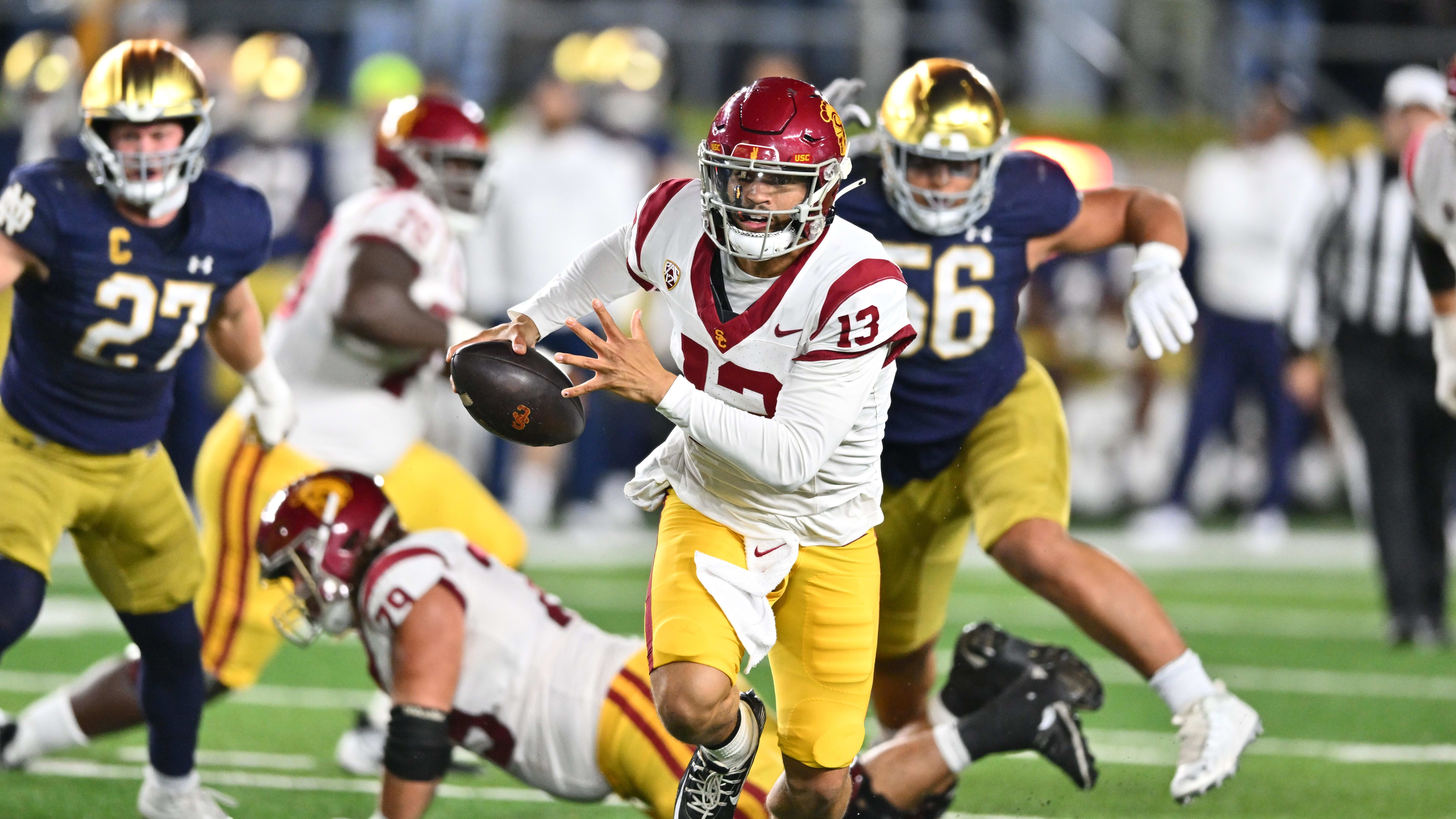
Despite playing the worst games in his college career against Notre Dame, Williams left a positive impression on Bears GM Ryan Pole in South Bend.
Matt Cashore-USA TODAY Sports
“You saw a lot of encouragement with teammates, even after the interceptions,” Poles says. “You saw frustration, too, because it matters to him. But you never saw it become disruptive. You never saw teammates run away from him, or him run away and be by himself, away from his teammates. You saw him talking with the coaches trying to find solutions.”
It was important to see, too, for a couple of reasons. First, every young NFL quarterback is going to have those moments, and how they handle them can color how veterans on their teams see them. Second, Poles went into assessing the quarterbacks with the knowledge, after two years on the job, that not everyone is cut out for the searing spotlight of playing quarterback in Chicago—with Fields providing a good example of a guy who could take the bullets that come with the job. Williams, in real time, was showing the poise to do it.
So, at that point, Poles had something, if small, to pair with the tape. He had a good view of Williams’s regimented warmup routine (“It had a Steph Curry feel to it,” Poles says.). He had the Montana moment. And he had Williams’s handling of a very, very difficult night.
Three months later, the Bears wrapped up an encouraging 7–10 campaign that ended with a 5–3 flourish, and Carolina helped Chicago in floundering to 2–15 and locking up the No. 1 pick for Poles and Eberflus. By then, Poles had a baseline of information to work off.
Some came from national scout Francis St. Paul and West Coast area scout Reese Hicks, who kept telling Poles that he needed to get back out to California, and around the people at USC. He’d find out, they promised, that the narratives that circled Williams while the Trojans’ season circled the drain weren’t real. Investigate it yourself, they said. Read our reports. Investigate it.
Meanwhile, Poles, assistant GM Ian Cunningham and director of player personnel Jeff King had drilled down on the tape and started to form a conclusion that Williams was simply different from the rest of the class. The issues he did show—mainly his fumbling and risk-taking tied to playmaking—could be coached. And he had stuff you couldn’t coach in spades, to the point that Poles was reminded of evaluating Patrick Mahomes as a young Kansas City Chiefs exec in 2017.
“The creativity, the rare instincts and feel to navigate in space and see the entire field, when you see a lot of those, that’s the part that’s interesting,” Poles says. “I stole some things that we did with Andy [Reid] when we watched tape of Pat and that whole class. I took a lot of short throws, the bubbles, the screens, the jet sweeps out and looked at the intermediate throws and the deep throws to see what the accuracy looked like there. That’s where the completion percentage and all that stuff starts to mess around with the evaluation.
“We wanted to see it at its purest form.”
Poles and Cunningham dove deeper, looking at all of Williams’s third downs on one cutup, all his two-minute plays on another, all his plays playing from behind on another. The conclusion, Poles says, kept coming back to a few realities: “The field vision, the arm strength, the accuracy, all of that was rare. The body type, you were just missing height. He’s thick and strong and stout in his lowers. He just has the ‘wow’ factor.”
And in doing all this, Poles and Cunningham were jamming on the accelerator because decisions loomed with Fields, who’d been a good soldier for them. At exit interviews, Poles told Fields that the situation the organization was faced with was unique, in that, again, the team had finished strong, and still had the first pick. He pledged to him to be transparent and honest, and repeated all of it to Fields’s agent, David Mulugheta.
As that was going on, Eberflus was running a parallel track. With incumbent OC Luke Getsy let go, and a coordinator search coming, the coach would be tasked with diving into the tape as aggressively as the front office had, with timing important to everyone, Fields included, as the path for the coming weeks was charted. The good news was, as Poles put it, “The tape part, that, to me, was the easier part of evaluating Caleb.”
In time, Eberflus would concur.
The harder part in these cases is almost always getting to know the person. Having to do it earlier, to service the expedited timeline, forced Poles to get creative.
The GM instructed all of his personnel people going to all-star games in January to ask players who went to either Oklahoma or USC, or were from Williams’s hometown of Washington, D.C., about the quarterback. Poles also assigned one of his scouts to call opposing coaches in the Big 12 and Pac-12, and in particular defensive coordinators who game-planned against him.
“That’s where things started to turn,” Poles says. “You started to get this feedback from players at the all-star games who were like, ‘I love this guy. I was in a rut and he helped pull me out. He’s a dude. He’s selfless. He takes care of his teammates before he takes care of himself.’ Two opposing defensive coordinators: ‘We had to change everything before we played him.’ If you’re doing that, that tells you enough about the kid’s talent.
“Two former coaches that were at Oklahoma were like, ‘Man, I watched his kid carefully, what a great teammate, he’d take the time to call defensive coaches and get a perspective of his game so he can adapt and adjust his game and get stronger.’ I’m looking at Ian and Flus and I’m like, If you duped this many people, you’re a psychopath. It was too consistent.”
And through Eberflus’s offensive coordinator search, he and Poles got to interview USC assistant Kliff Kingsbury, where they’d get insight on Williams’s dad, Carl, who’d gotten a reputation as a helicopter parent. When they raised that, Kingsbury swiftly cut them off.
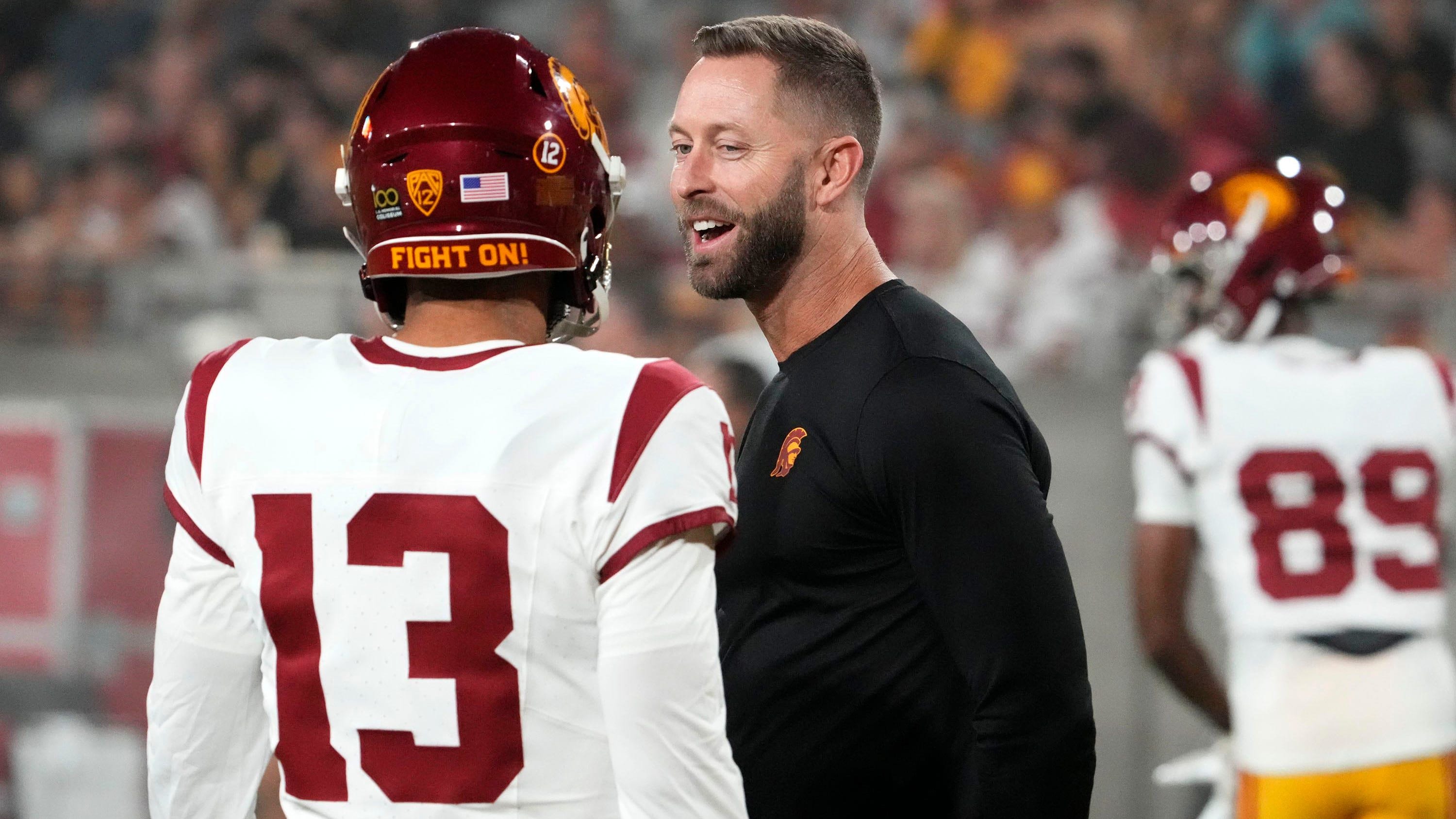
When Kingsbury interviewed for the Bears' OC position, he helped clarify some narratives about Wililams, who Kingsbury worked closely with at USC.
Rob Schumacher/The Republic / USA TODAY
“Don’t even go there,” Kingsbury told the Bears’ guys. “You’ve got a businessman who’s just looking to put his son in the best situation, on the business side of things. When it comes to football, yes, he’ll want to set him up to make sure he’s in a good situation. Once that happens … it’s all good.”
At the interview in Los Angeles, Kingsbury told the Bears he’d seen Carl Williams once at the USC football facility all year.
As fate would have it, the former Arizona Cardinals coach wound up back in the NFL, landing as OC for the team that had the second pick, the Commanders, rather than the one with the first. The Bears wound up with former Seattle Seahawks OC Shane Waldron, picking him for his experience, his system and his work with quarterbacks, which most recently included bringing Geno Smith’s career back from football purgatory.
Once Waldron was aboard, Eberflus and the coaches could complete the tape review which, unsurprisingly, matched closely with what Poles and his scouts had. And it happened with Eberflus efforting not to talk to anyone, most notably, the Bears’ personnel staff, about the quarterbacks first, so he could get a pure, unprejudiced view of each one. Williams jumped off the screen.
“I just watched it that way and I found myself looking at it and it was pretty evident pretty quick that the arm talent is what stood out,” Eberflus says. “The accuracy, and, really, to me, [with] the really good quarterbacks, you always look for the ball speeds. So he can really change the ball speed when he’s throwing a screen, when he’s throwing a fade, when he’s throwing an in-cut. He understands space, open space, and has the natural ability, the instincts to really change that ball speed when necessary to be accurate.”
Eberflus would later meet with Williams’s throwing coach, Will Hewlett, and put science next to his evaluation. Hewlett told Eberflus that where most quarterbacks biomechanically have four-mph range on their throws, from touch throws to drive throws, Williams had a staggering 10-mph range, which quantified the control he had over the ball.
It was another brick in the wall. As the combine approached, a decision was crystallizing.
As he had at the 2023 combine, Poles reserved a room at the Hyatt Regency in downtown Indianapolis, in an effort to be a little more out-of-the-way than he’d be if he was staying at the bustling JW Marriott or Downtown Marriott. Last year, it was about not having everyone approaching him about trading the first pick. This year, likewise, it allowed for him to discreetly have some visitors to the suite the Bears booked for him.
Knowing Williams wouldn’t throw or work out, and already having dialed in on him as the guy if Chicago was going to trade Fields, Poles had two big boxes to check. One, he and the staff would have their 15-minute formal interview with Williams, their first chance to go face-to-face with the Heisman winner. Two, Williams’s team would come visit Poles in their suite.
On the former, the Bears had Williams as the last guest to their suite at Lucas Oil Stadium.

Although Williams didn't work out or throw during the combine, the Bears still used the time in Indianapolis to get to know the QB better.
Kirby Lee-USA TODAY Sports
Williams strode easily into the room on that Wednesday night, at 10:40 p.m. Chicago, for its part, doesn’t have a room that’s trying to break a guy in those 15 minutes to see how he reacts. The atmosphere was relaxed. The Bears started with Waldron and the coaches teaching Williams a concept from the team’s new playbook. They went through some of Williams’s tougher moments at USC, to see if he’d take ownership for them. Then, they settled into normal conversation.
“You just recognized that he’s easy to talk to,” Eberflus says. “Personality is there. He’s a guy’s guy. He’s gonna fit in with his teammates.”
At the end of the session, with Poles, Eberflus, Cunningham, Waldron, team president Kevin Warren and pass-game coordinator Thomas Brown watching, the Bears asked that he teach the play they’d given him back to them. Williams did that with ease.
Two days later, on Friday of combine week, Poles welcomed members of Williams’s team to his suite at the Hyatt. Among the five guys to represent him was a lawyer and a body work guy, and a trainer, and in talking through things with them a clearer picture emerged for the Bears on how the kid approached the sport.
“You knew that structure mattered to him,” Poles says. “There were people in place to help him be successful. As you went along, you understand there’s people put in place that are there that allow him to play ball to be the best player he can be. It’s not like, ‘Hey, I have a team to say I have a team.’ Everybody’s got a role, and it’s to allow him to be the best football player he can be and eliminate as many distractions and stresses as possible.
“A lot of times we have to help them put structure together. This kid already has it there for him.”
Another detail that emerged from the meeting—Williams had rented out a field at a local high school to throw in the downtime he got through his week in Indy.
Even with the increasing inevitability that he’d be the first pick, he wanted to be at his very best for the pro day, two and a half weeks later on March 20. The Bears had previously scheduled Williams’s 30 visit, where they’d bring him to Halas Hall in Chicago’s north suburbs, for the following Tuesday, March 6, as part of their ongoing effort to speed up the process.
But sensing that Williams returning to L.A., then flying back to Chicago, and back to L.A. again may not serve anyone’s best interest, Poles resolved with Williams and his group to reschedule that visit for after the pro day, with plans for dinner next on the calendar, two nights ahead of USC’s pro day in California.
Before going back to Los Angeles, the Bears had to firm up the decision to move on from Fields, one that wasn’t easy for Poles or Eberflus because of the person their now former quarterback is, steady and tough as nails, as they’d worked through two years of rebuilding.
The hope in doing the 30 visit on March 6 was that they could check a last box—getting Williams to go through a physical—before moving Fields. But with Williams’s trip to Chicago rescheduled, and the start of free agency, when quarterbacking chairs would fill up, the time to wait and be patient was passing. The market for Fields hadn’t quite developed, but the Pittsburgh Steelers’ dustup with, and subsequent trade of, former first-rounder Kenny Pickett over the Russell Wilson signing gave Chicago an opportunity.
Knowing it’d be a good landing spot for Fields, Poles worked with the Steelers on trading the quarterback there for a 2024 sixth-rounder that would become a fourth if Fields played more than half the snaps. And as he closed in on the deal, on St. Patrick’s Day morning, Poles drove over to Eberflus’s house so the two could deliver the news to Fields together.
“We thanked him for his leadership, for the work ethic and just the man that he is, how he’s always been a wonderful guy,” Eberflus says. “I just told him, ‘Hey, I really enjoyed our relationship together the last couple years.’ I said, “That certainly doesn’t end here.’ The relationship that he and I built over the first couple years is special and no one can ever take that away from us.”
They thanked Fields for everything. Fields thanked them, and said he appreciated their alignment and open communication through a difficult few weeks. And then, Poles and Eberflus started calling team leaders, to let them know the trade was coming before the news of it broke.
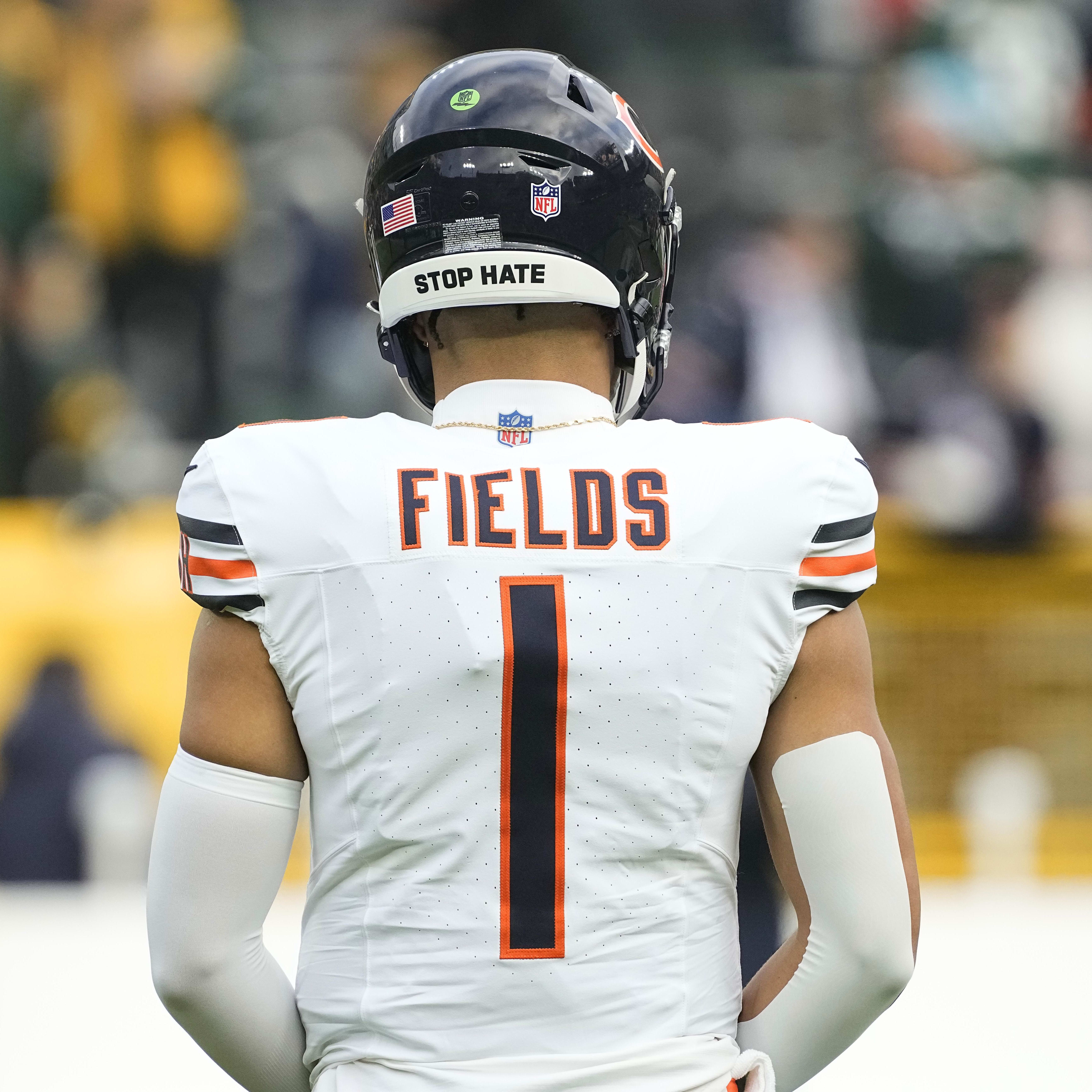
Sending Fields to the Steelers was one of the last puzzle pieces for Chicago's plan to take Williams in the draft.
Jeff Hanisch-USA TODAY Sports
Two nights later, the Bears were at The Bird Streets Club in West Hollywood, with Williams and a smattering of his USC teammates.
Williams, the Bears’ contingent noticed, never took his phone out of his pocket once. As it had been in Indy, the conversation came easily. In a lot of cases, Williams, in the most natural way, was carrying the conversation. He made eye contact with everyone.
“We just wanted to see how he interacted,” Eberflus says. “And really the only thing that you can glean from [a dinner like that] is personality. He could talk about a wide range of topics and with ease. Very conversational, personality is really good. So that was cool.”
Knowing the Bears were getting between four and five hours with Williams the next day at USC, on the Tuesday before the Wednesday pro day, Eberflus asked his colleagues to give him an hour with the quarterback one-on-one, to start Williams’s day.
The two sat down and went through his entire football journey, with much of the discussion moving to the support Williams’s parents had given him along the way, from the decision to switch from running back to quarterback in youth football, to coming up with a plan when he was in high school and pouring into it, to transferring after his freshman year and following coach Lincoln Riley from Oklahoma to USC.
“I found out during that conversation that his parents are so supportive, do anything for him, love him and have been great the entire way,” Eberflus says. “And it’s really a tribute to them, the kind of man he is, and the kind of character he has now.”
Eberflus then took Williams through the Bears’ rebuild, where the locker room was from a leadership standpoint, the progress they’d made through two years, and how he felt like the quarterback was fortunate to be coming to a team that wasn’t at ground zero. And as he did that, losing track of time, not knowing he’d gone 15 minutes over his allotted hour already, Eberflus got a text from Poles, half-joking, “You getting close to being done in there?”
Eberflus responded that it was important for the two of them to finish up.
They did, and the larger group then came in, with Waldron taking charge from there, running a three-hour meeting hyper-focused on football. The OC went back to what the Bears had taught Williams at the combine, and he was able to recall it. The Bears kept testing his recall, and he kept passing those tests, as they went through an install. He asked questions. He was on it. And it made the rest of the visit to L.A., with Williams’s throwing session on deck, a formality.
“He’s not one of these kids that acts like they have it figured out and then you stump them later,” Poles says. “If he was uncomfortable, he’d want to go back and learn it again. He had really detailed structure to how he takes notes—that stood out. Pro day itself, that part, throwing the ball is easy for him, so just seeing him work under center, footwork, all of that comes easy to him. The on-the-field stuff was the least of my concerns.”
There was one surprise during the workout, though. One of Williams’s future teammates, Keenan Allen, showed up for it. The Bears told Allen, when he came in for his physical after the Bears traded for him, that they’d be in L.A. for the pro day. But there was no expectation Allen would show up for it. That he did was a nice twist to a good week for the team. It also foreshadowed the next, and final, step.
Williams was one of six draft prospects to arrive for their 30 visits in Chicago on the night of April 2, with Oklahoma tackle Tyler Guyton, West Virginia center Zach Frazier, Alabama rusher Dallas Turner, Boston College corner Elijah Jones and Miami safety Kam Kinchens.
The Bears had Guyton, Frazier, Turner, Jones and Kinchens go with a group of coaches to Eddie Merlot’s in nearby Lincolnshire for dinner. Meanwhile, Williams was sent to Sophia Steak in Lake Forest, where he’d meet a crew of his future teammates—tight end Cole Kmet, guard Teven Jenkins, linebacker T.J. Edwards, and receiver DJ Moore—in a private room. Poles dropped Williams off there, and went to eat in another part of the restaurant.
The idea was one he and Eberflus had mulled for a while.
“We said, ‘I think it would be good that he meets with our players because that’s ultimately what matters,’” Eberflus says. “Ultimately, he’s going to be a teammate of these guys.’ And we want to get their feedback on, exactly, Is he a good teammate? Is he a guy’s guy? Is he easy to talk to? Is he easy to get along with?”
Check, check, check and check.
“You can’t fool the locker room,” Poles continues. “We got this roster and our leadership group, the core of it, in a really good place. They’re a bunch of really good human beings, so I thought it was important for them to be a part of this journey and this decision. I wanted them to make sure that they saw for themselves what this kid stood for and his passion for the game. I just felt like that was really important.
“As a staff, we’d spent so much time with him, at that point, that we all felt comfortable. I wanted our players to get a feel for him, and they did. The feedback was outstanding.”
The next day, the Bears repeated some of the things they’d already done, and some things that Poles had borrowed—or, to use his word, “stole”—from Reid and the Chiefs.
The coaches again installed with Williams early in the day and, after a midday break, came back to it and asked him to teach it back to test his recall. That was no more of a problem in Chicago for Williams than it had been in Indy or Los Angeles.
They also, finally, got the medical box checked with Williams. They’d been O.K. delaying it in March, even though it meant trading Fields without getting a physical on Williams first, because Williams really only had the pulled hamstring his sophomore year in college as a documented issue. But there was some relief, and finality, that came with the physical returning clean.
And they got to see Williams in what would be his workplace three weeks later, and watch as he got a first-hand view of the resources there, and what had been built, and would be in place for him, when he arrived for good.
“You’re not selling yourself, but at the same time, you do want to show all the way from the top, there’s an investment to the players that are here and we’re not really playing around with that,” Poles says. “I like all the guys seeing that. It was cool for him to see that too.”
Later in the day on April 3, Williams left one last time before the draft and everyone in the Bears’ building had a good feeling about where things were going.
But no promises were made.
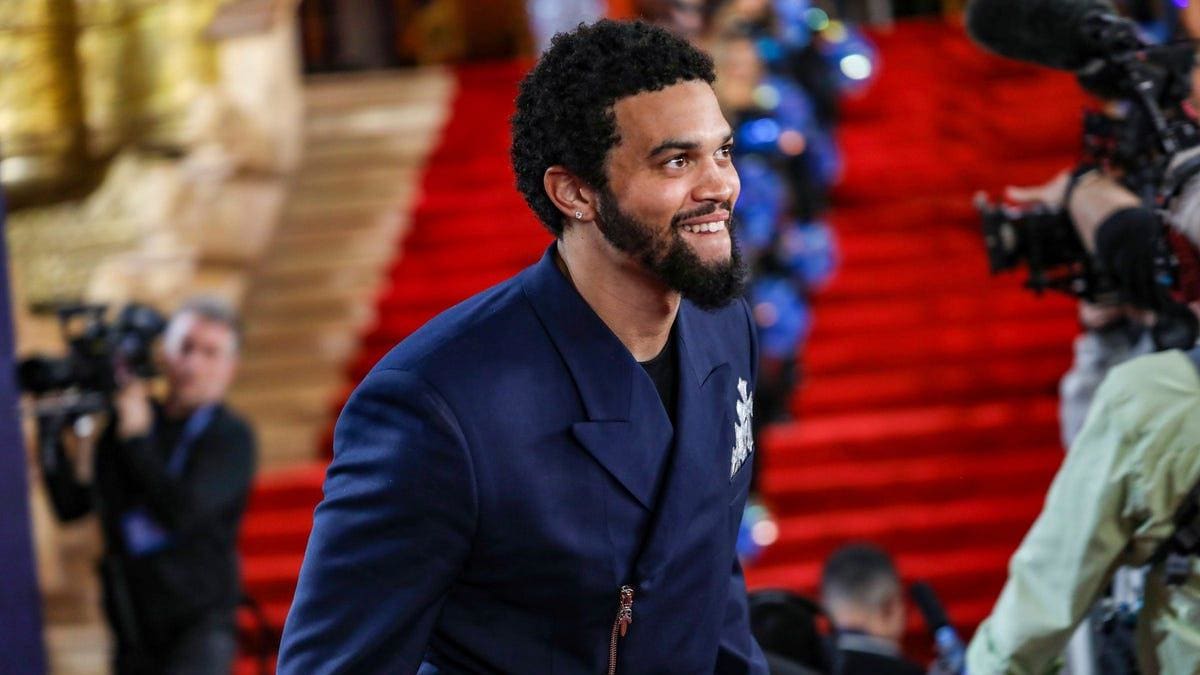
"You only get to go to the draft once in your life. We wanted to keep that as authentic as we possibly could," Poles said of not confirming that the Bears would pick Williams until the night of the draft.
Kimberly P. Mitchell / USA TODAY NETWORK
Of course, everyone knew what was going to happen.
Still, Poles and Eberflus wanted to give Williams his day.
“It’s not like I kept him in the dark by any means,” Poles says. “There was some conversation about some things you talk about, that have to do with the future—Next week, this’ll happen, that’ll happen. I never gave him that official, Hey. we are taking you tomorrow, conversation. Was it a surprise to him? No, but I wanted him to go appreciate the process. You only get to go to the draft once in your life. We wanted to keep that as authentic as we possibly could."
So on the phone on draft night, Poles told Williams the league told him to hold the pick for five minutes, and he joked he’d been holding it for a month. Williams shot back that the Bears had been holding it for five months.
Of course, it hadn’t been that long. But this had become such an obvious decision for Chicago, that Williams’s guess on it wasn’t that far off.
And with it done, Poles could reflect back on the start of all this, and cutting the deal with former Panthers GM Scott Fitterer a year ago, when the Panthers came up from No. 9 to No. 1 to get their own franchise quarterback, sending Moore and a package of picks to the Bears in return. Never, at that time, could Poles have imagined that Williams would be part of that deal.
“It was a move I made, one, because I wanted to continue to evaluate Justin, and two, I knew we had to keep building our football team, Poles says. “We needed more players to close the gap on some of the years prior, with all the trades before. It was just a move to improve the football team.”
The GM then paused, and continued, “It ended up being a jackpot situation.”
With that luck on their side, the Bears wound up arriving at the conclusion most figured they would once Carolina secured the first pick for them. But they didn’t get there without doing a lot of work first. And now, with that work done, the quarterback Poles saw in South Bend can go about the business of chasing guys like the one he endeavored to meet that night.
